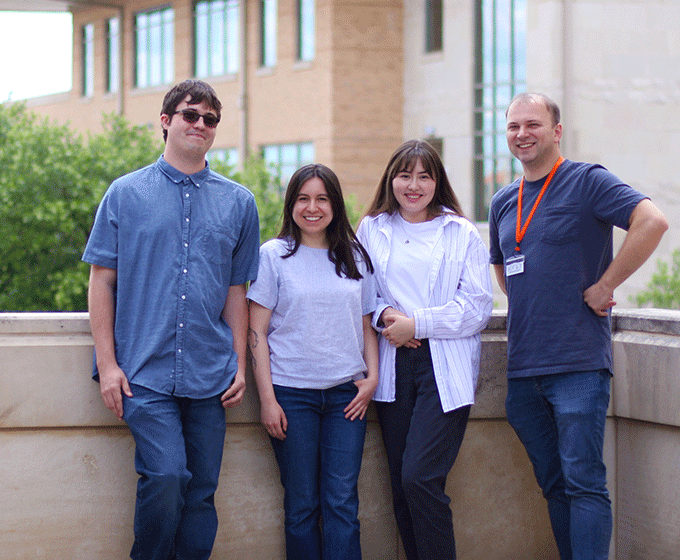
Dustin Fetch, graduate student; Cameron Chapa, research associate; Amina Jumamyradova, undergraduate assistant and Dr. Alexey A. Soshnev are a part of the Soshnev Laboratory.
APRIL 16, 2024 — Dr. Alexey A. Soshnev, an assistant professor in the UTSA Department of Neuroscience, Developmental and Regenerative Biology, has received a three-year, $1 million grant from the Cancer Prevention & Research Institute of Texas (CPRIT) to understand fundamental mechanisms driving transformation and progression of lymphomas — the malignancies arising from peripheral B-cells, a type of white blood cell found in the bloodstream and lymphatic system, and the cause of two common cancers: Hodgkin lymphoma and non-Hodgkin lymphoma.
Soshnev’s project, “Understanding the Mechanism of Linker Histone Mutations in Malignancy,” received an Individual Investigator Research Award (IIRA), one of CPRIT’s most competitive grants. CPRIT awards IIRA funding to about 10% of the applications it receives.
According to the National Cancer Institute, there were more than a million people living with B-cell lymphomain the United States in 2020. While several treatment options are available and the prognosis is generally positive, lymphoma five-year mortality rates range between 10 and 25% for different subtypes.
Soshnev’s research focuses on chromatin, a polymer complex comprised of DNA and associated proteins. Chromatin plays a critical role in all cellular processes where DNA is involved, such as cell division, DNA damage repair and gene regulation. Histones are the most abundant class of chromatin proteins, and several classes of histones contribute to both structural and regulatory mechanisms in DNA.
“It is fascinating,” Soshnev says, “that while your genetic code is largely unchanged in development, interpretation of this code is vastly different across cell types. For example, neurons express ‘neuronal’ genes, while muscle cells express ‘muscle’ ones. Dynamic modifications of histones in chromatin are one way to demarcate ‘active’ and ‘repressive’ neighborhoods in the chromosomes.”
Soshnev continued, “This project started as an attempt to answer a fundamental question—how are chromatin compaction, gene expression, and histone modifications related to each other. However, we quickly realized that these very fundamental questions have an immediate real-world application.”
Soshnev and collaborators recently demonstrated that chromosome decompaction can precipitate a chain of events leading to malignant transformation, and over a third of patients diagnosed with B-cell lymphoma carry somatic (i.e. tumor-specific) mutations in genes encoding H1 histones.
Soshnev and his team will decipher the genetic dependencies, consequences, and vulnerabilities of H1 loss in B-cell malignancy. Understanding the specific downstream effects of H1 histone loss can provide a new way to rescue the effects of these mutations.
“Our results show that H1 histones act as tumor suppressors in B-cells. H1 loss drives the stem cell programs in fully differentiated cells, in effect sending them back in time and increasing the potential to progress into cancer,” Soshnev said. “However, a lot of details of how H1 mutations lead to malignancy remain unknown and are something we’d like to learn more about. Beyond H1 mutant lymphomas, our findings will be immediately relevant to an emerging class of malignancies associated with aberrant chromatin decompaction.”
Soshnev earned an M.D. from St. Petersburg State University Faculty of Medicine in Russia and a Ph.D. in molecular and cellular biology from the University of Iowa. He joined UTSA as a faculty member in 2022 after completing a postdoctoral fellowship at The Rockefeller University in New York.
The Soshnev Laboratory is interested in how information encoded in DNA is interpreted, modified and propagated. His team aims to understand how specific gene expression programs are established in development and how mutations in chromatin factors can lead to human disease.
CPRIT was formed in 2007 with an initial $3 billion investment from the state of Texas to fight against cancer. CPRIT is now a $6 billion, 20-year initiative and is the largest state cancer research investment in the history of the United States and the second largest cancer research and prevention program in the world.
UTSA Today is produced by University Communications and Marketing, the official news source of The University of Texas at San Antonio. Send your feedback to news@utsa.edu. Keep up-to-date on UTSA news by visiting UTSA Today. Connect with UTSA online at Facebook, Twitter, Youtube and Instagram.
Move In To COLFA is strongly recommended for new students in COLFA. It gives you the chance to learn about the Student Success Center, campus resources and meet new friends!
Academic Classroom: Lecture Hall (MH 2.01.10,) McKinney Humanities BldgWe invite you to join us for Birds Up! Downtown, an exciting welcome back event designed to connect students with the different departments at the Downtown Campus. Students will have the opportunity to learn about some of the departments on campus, gain access to different resources, and collect some giveaways!
Bill Miller PlazaCome and celebrate this year's homecoming at the Downtown Campus with food, games, giveaways, music, and more. We look forward to seeing your Roadrunner Spirit!
Bill Miller PlazaThe University of Texas at San Antonio is dedicated to the advancement of knowledge through research and discovery, teaching and learning, community engagement and public service. As an institution of access and excellence, UTSA embraces multicultural traditions and serves as a center for intellectual and creative resources as well as a catalyst for socioeconomic development and the commercialization of intellectual property - for Texas, the nation and the world.
To be a premier public research university, providing access to educational excellence and preparing citizen leaders for the global environment.
We encourage an environment of dialogue and discovery, where integrity, excellence, respect, collaboration and innovation are fostered.